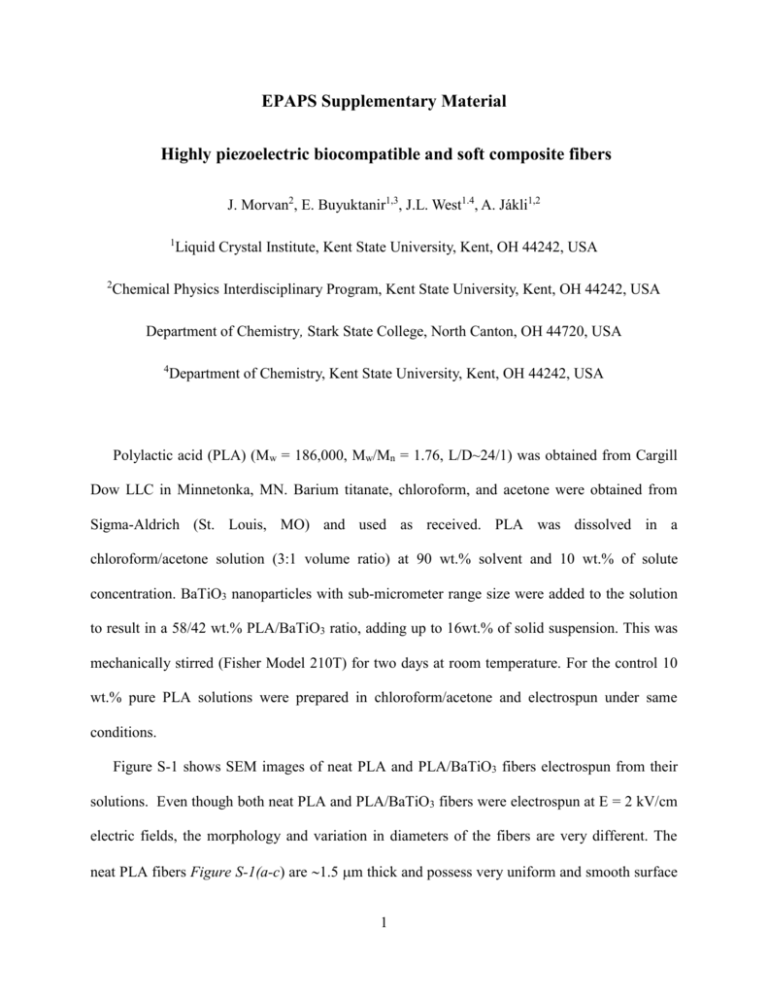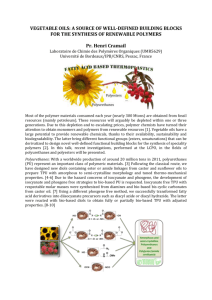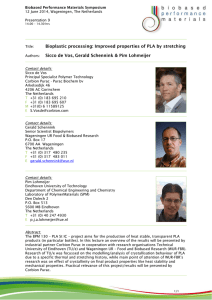morvan apl EPAPS_2nd_rev
advertisement

EPAPS Supplementary Material Highly piezoelectric biocompatible and soft composite fibers J. Morvan2, E. Buyuktanir1,3, J.L. West1.4, A. Jákli1,2 1 2 Liquid Crystal Institute, Kent State University, Kent, OH 44242, USA Chemical Physics Interdisciplinary Program, Kent State University, Kent, OH 44242, USA Department of Chemistry, Stark State College, North Canton, OH 44720, USA 4 Department of Chemistry, Kent State University, Kent, OH 44242, USA Polylactic acid (PLA) (Mw = 186,000, Mw/Mn = 1.76, L/D~24/1) was obtained from Cargill Dow LLC in Minnetonka, MN. Barium titanate, chloroform, and acetone were obtained from Sigma-Aldrich (St. Louis, MO) and used as received. PLA was dissolved in a chloroform/acetone solution (3:1 volume ratio) at 90 wt.% solvent and 10 wt.% of solute concentration. BaTiO3 nanoparticles with sub-micrometer range size were added to the solution to result in a 58/42 wt.% PLA/BaTiO3 ratio, adding up to 16wt.% of solid suspension. This was mechanically stirred (Fisher Model 210T) for two days at room temperature. For the control 10 wt.% pure PLA solutions were prepared in chloroform/acetone and electrospun under same conditions. Figure S-1 shows SEM images of neat PLA and PLA/BaTiO3 fibers electrospun from their solutions. Even though both neat PLA and PLA/BaTiO3 fibers were electrospun at E = 2 kV/cm electric fields, the morphology and variation in diameters of the fibers are very different. The neat PLA fibers Figure S-1(a-c) are 1.5 m thick and possess very uniform and smooth surface 1 topology. On the other hand, Figure S-1 (d to f) shows that the BaTiO3 nanoparticles are spatially confined and formed microdomains within the PLA matrix. The diameter of the PLA/BaTiO3 fiber varies between 0.2 and 3 m. The increase of the fiber size, and the appearance of the porosity are already observed earlier.1,2,3,4 It is also reported that the use of multi-solvent systems for PLA spinning is one of the important parameters to manipulate the surface topography of the fibers.5 Figure S-1: SEM micrographs of (a)-(c) neat PLA fibers (electrospun at 20 kV, 10 cm, and 0.6 mL/h); (d)-(f) PLA/BaTiO3 fibers (electrospun at 20 kV, 10 cm, and 0.4 mL/h). Figure S-2: shows the optical microscopic textures of a thin (d=20m) mat before (a) and after (b) heating to 130oC for two hours; and in a thick (d=200m) mat containing 42wt% of BT nanoparticles. One can see that the PLA polymer stays in fiber forms even after keeping the sample at 130oC for two hours to unpole the BT particles. While the TG of PLA is around 70oC, melting occurs above 160oC. 2 50m (a) ( b) ( c) Figure S-2: Polarizing optical microscopy images of a thin (d=20m) mat before (a) and after (b) heating to 130oC for two hours; and in a thick (d=200m) mat containing 42wt% of BT nanoparticles. The electrospinning set-up consists of a KDS Model 100 programmable syringe pump and a high-voltage power supply (Gamma High Voltage Research Inc., FL). The syringe was a Popper Micro-mate 5 mL glass syringe with a 24-gauge metal needle. The fibers were collected on indium-tin-oxide (ITO) coated glass substrates (Corning, 1.1 mm thick). The PLA/BaTiO3 (52/48 wt.%) suspension was drawn into the syringe and injected with a metal needle using a syringe pump. The fibers were electrospun by applying 18 - 25 kV voltages at a rate of 0.4 mL/h between the tip and the collector being 10-15 cm apart. The movement of the top substrate under application of a DC voltage was measured by a Leitz Mirau Interferometer as a function of the amplitude and sign of the external voltage applied to the cell. A green filter was utilized to measure field-dependent changes of the interference patterns found on the cell surface upon application of the field. The green filter gave a constant periodicity as well as defining a single wavelength to the interference fringes. A movement of the top substrate, d , would cause a change in the path length of the light beam reflecting off of 3 the substrate. Consequently, a horizontal shift by x of the fringes occurs, as explained in Figure S-2 (d). The vertical displacement can be related to the horizontal shift by the relation, d ( / 2) (x / L) (S.1) where L is the distance between two maxima of the interference pattern. A typical microscope image captured through the Mirau interferometer is shown in Figure S-2(a). The displacement of the fiber mat measured at the center of the cell was obtained from video analysis of the interference pattern shift for green light in comparison with Eq.(S.1). The results represent mainly linear electromechanical (LEM) properties of the PLA/BaTiO3 fibers. The spontaneous electric polarization of the ferroelectric BaTiO3 particles is approximately P~0.15 C/m2 6, so the typical surface charge density of electrospun fibers is only in the range of 10-5nC/m2 , and contributes only to the quadratic electromechanical signal.7 Therefore, the role of the surface charges was neglected interpreting the LEM results. Similarly, possible bound charges that may result from non-homogeneous electric fields can be excluded, because they would appear only in QEM signals. 4 Figure S-3. Experimental set-up for electro-mechanical characterization of fibers. The Mirau interference patterns (a) are created between a reflection reference mirror in the center of the objective lens (b) and the fiber cell top substrate (c). When the system is focused upon the surface, localized interference fringes will appear due to the reflected light. The cell compression or expansion due to applied field causes a shift in the interference pattern, which is recorded and analyzed. Molecular structure of PLA is shown on the right (e). For the AC field measurements a light weight (m = 2.5 g mass) accelerometer (BK 4375 from Bruel&Kjaer) was attached to the cover plate of the fiber mat by a double-stick tape provided by Bruel&Kjaer. With a EG&G 7265 Lock in Amplifier, we measured the amplitude and phase of the electric current I = dQ/dt, where Q is the electric charge induced on the accelerometer by an acceleration a d 2 with a conversion coefficient of c=Q/a=0.318pC/(m/s2). As the 5 applied voltage was set to sinusoidal waveform, we measured the 1st harmonic of the signal (linear effect), I Q , where is the angular frequency of the applied voltage, which means that d I / 3c . To avoid any error arising from the electrical signal picked up from the wires, we used a modified electric current I* = I-Inc, where Inc is the current measured when the accelerometer was fixed to the vibration isolating table next to the cell. We found that below 150-200 Hz Inc was not negligible (~15%), and the noise was relatively large. For this reason here we show results obtained only above 200 Hz, where the error is less than 5%. The film thickness was measured by placing the cell perpendicular to the microscope stage and viewing the cell using 5X magnification. This allowed the distance between the inner surfaces of the substrates to be viewed at different edges of the cell. Measurements were taken at each of the four corners of the cell in order to obtain an average of the cell thickness as well as local thickness corresponding to the four different spots. The Young modulus was measured using the Mirau interferometer mounted on the microscope. Analysis was done by taking a circular ring of known mass and dropping the ring onto the top substrate of the cell. This causes a change in the cell thickness due to the weight of the ring compressing the mat. The horizontal displacement of the fringes was measured the same way as for the DC displacement measurements using the top substrate. The Young modulus can be calculated by Y ( F / A) ( S / s ) given that A 4cm 2 and S 200 m . With the mass of the ring being m 1.4 g , the force applied to the mat is F 0.014N . The displacement of the fringes was found to be s 440nm , giving a Young modulus of Y 1.6 104 N / m 2 . The dielectric studies have been carried out by using a Schlumberger 1260 impedance/gainphase analyzer in the frequency range 200 Hz – 0.1 MHz with the maximum applied measuring 6 voltage of 0.1 V (RMS). For the impedance measurements a 4 wired configuration has been used in order to eliminate the distortive contribution of the connecting wires. To avoid high frequency distortions, the instrument has been calibrated with a 1k resistor. The dielectric properties of the composite mats were measured at room temperature. We found that the dielectric constant was about 1.1±0.03 in the entire frequency range studied. To find the permittivity of a composite from the dielectric constant of the constituent components, we use the Lichtenecker logarithmic m mixing rule8: log i log i , where i are the volume ratios of the individual components i 1 (0.01, 0.04 and 0.95 for the BaTiO3, PLA and air, respectively), and i are the static dielectric constants of the constituent materials (3000-5000 for the BaTiO3 nanoparticles9-13 , ~3 for the PLA4, and ~1 for the Air). With these numbers the logarithmic mixing rule provides =1.14 in good agreement with the measurements. Neat electrospun PLA fibers showed only compressions and no expansion within the experimental error of about 5 nm. Along with pure PLA fibers, only compression was seen for casted films of PLA and BaTiO3. Linear electromechanical responses (LEM) are sensitive to the sign of the external field, i.e. an external periodic field would result in mechanical vibrations at the same frequency. The absence of any measurable LEM response is somewhat surprising, because optically active PLA materials have been known to present shear piezoelectricity (which is a LEM effect) with the piezoelectric constant of 10 pC/N.4 However, shear piezoelectricity would not cause any thickness changes, and shear piezoelectricity occurs only in highly oriented crystalline structure, which can only be obtained by drawing treatment.12-18 Thermal behavior of pure electrospun PLA fiber mats has been studied in some of our previous work.19 Differential Scanning Calorimetry (DSC) results showed that the pure PLA mats exhibit a cold 7 crystallization peak and very low crystallinity (6.6 %). The WAXD analysis also confirmed that electrospun PLA fibers possess an amorphous structure.19 The reason for the low crystallinity of PLA fibers is the result of rapid solidification of the fluid jets at high solvent evaporation rates preventing the formation of ordered domains.20Therefore we understand the lack of LEM in pure PLA fibers. References 1 A. Greiner, J.H. Wendorff, Angew. Chem. Int. Ed. 46, 5670 - 5703 (2007). 2 L.-T. Lim, R. Auras, M. Rubino, Progress in Polymer Science 33, 820-852 (2008). 3 C. Xiang, Y.L. Joo, M.W. Frey, M. W. J. Biobased Materials and Bioenergy 3, 1-9 (2009). 4 D. H. Reneker, A. Yarin, Polymer 49, 2387-2425 (2008). 5 M. Bognitzki, W. Czado, T. Frese, A. Schaper, M. Hellwig, M. Steinhart, A. Greiner, J.H. Wendorff, J. H.. Adv. Mater. 13, 70-72 (2001). 6 V. K. Wadhawan,. (2000). Introduction to ferroic materials. CRC Press., New York p. 10 7 V.E. Kalayci, P.K. Patra, Y.K. Kim, S.C. Ugbolue, S.B. Warner. Polymer, 46, 7179172000 (2005) 8 "Ferroelectric polymers: chemistry, physics, and applications", Ch. IX: E. Fukada: Piezo, and pyroelectricicty of Biopolymers, Editor: H.S. Nalwa, Marcel Dekker, Inc. (1995) 9 S-H. Xie, B-K. Zhu, X-Z-Wei, Z-K. XU, Y-Y. Xu, Applied Sciences and Manifacturing, 36, 1152-1157, (2005) 10 B. Carlberg, J. Norberg, J. Liu, 2007 IEEE, pp. 1019-1026 of ElectronicComponents and Technology Conference 11 Y.C. Li, S.C. Tjong, R.K.Y. Li, eXPRESS Polymer Letters, 5 (6), 526-534 (2011) 8 2007 12 T. Hoshina, H. Kakemoto, T. Tsurumi, S. Wada K , Key Engineering Materials 350, 47-50 (2007) 13 T. Hoshina, H. Kakemoto, T. Tsurumi, S. Wada K , M. Yashima, J. Appl. Phys. 99, 054311 (2006) 14 E. Fukada, Biorheology 32, 593-609 (1995). 15 E. Fukada, IEEE Trans. on Ultrasonics, Ferroelectrics, and Frequency Control 47, 12771290 (2000). 16 S. Sasaki, T. Asakura, Macromolecules 36, 8385-8390 (2003). 17 E. Fukada, Jpn. J. Appl. Phys., 37, 2775 (1998). 18 T. Nakiri, M. Okuno, N. Maki, M. Kanasaki, Y. Morimoto, S. Okamoto, M. Ishizuka, K. Fukuda, T. Takaki, and Y. Tajitsu, Jpn. J. Appl. Phys.,44, 7119-7122 (2005). 19 E. A. Buyuktanir,M.W. Frey, J.L. West, J. L. Polymer 51, 4823-4830 (2010). 20 T. Subbiah, G.S. Bhat, R.W. Tock, S. Parameswaran, S.S. Ramkumar, J. of Appl. Polym. Sci. 96, 557-569 (2005). 9





